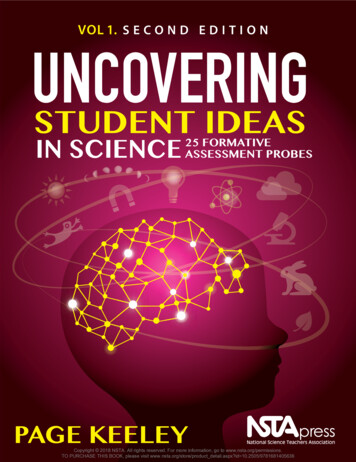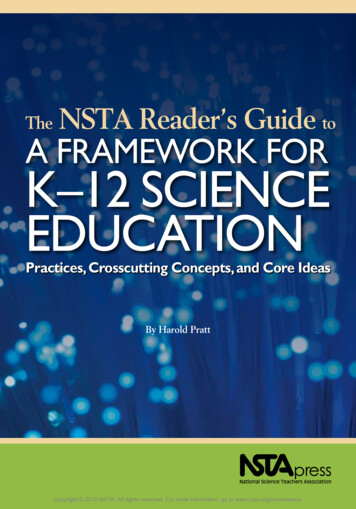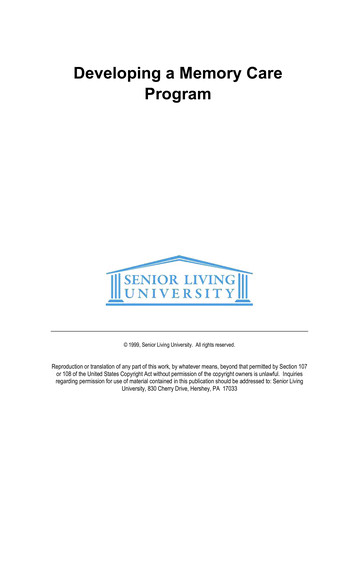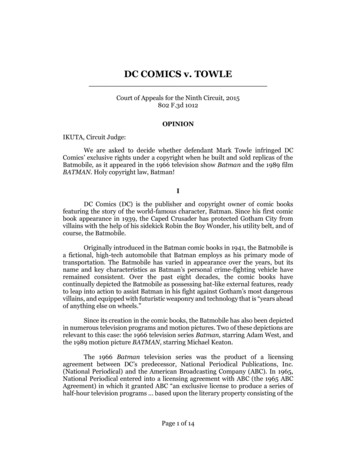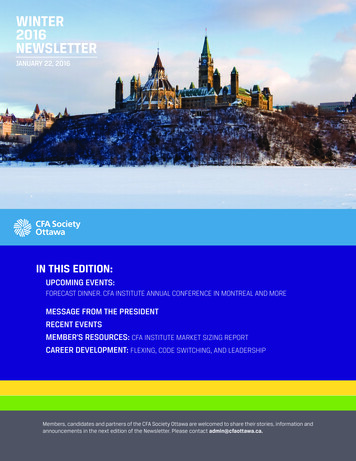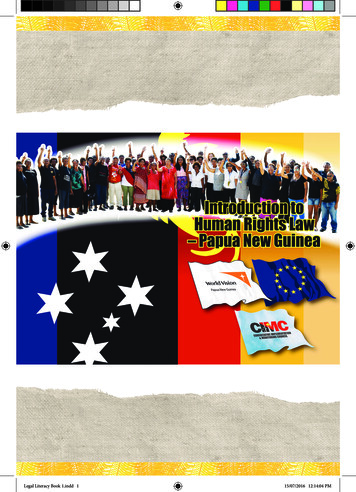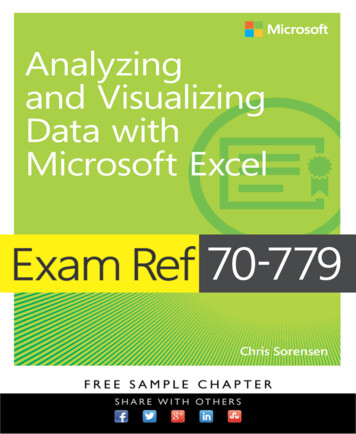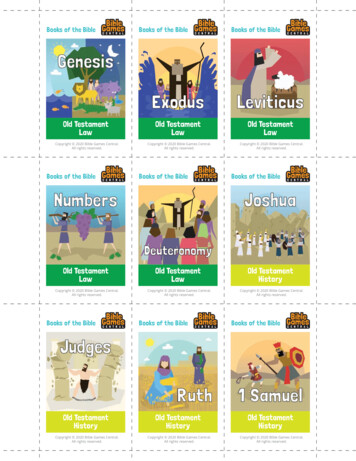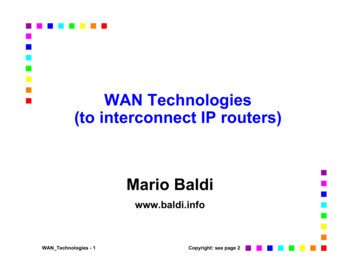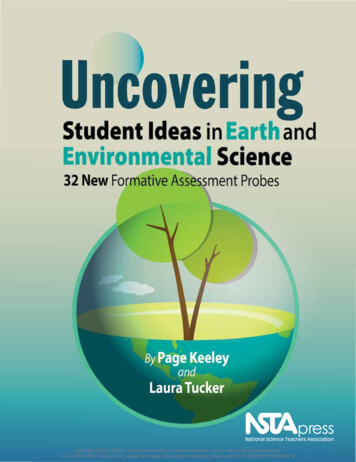
Transcription
Copyright 2016 NSTA. All rights reserved. For more information, go to www.nsta.org/permissions.TO PURCHASE THIS BOOK, please visit www.nsta.org/store/product detail.aspx?id 10.2505/9781938946479
Copyright 2016 NSTA. All rights reserved. For more information, go to www.nsta.org/permissions.TO PURCHASE THIS BOOK, please visit www.nsta.org/store/product detail.aspx?id 10.2505/9781938946479
Copyright 2016 NSTA. All rights reserved. For more information, go to www.nsta.org/permissions.TO PURCHASE THIS BOOK, please visit www.nsta.org/store/product detail.aspx?id 10.2505/9781938946479
By Page KeeleyandLaura TuckerArlington, VirginiaCopyright 2016 NSTA. All rights reserved. For more information, go to www.nsta.org/permissions.TO PURCHASE THIS BOOK, please visit www.nsta.org/store/product detail.aspx?id 10.2505/9781938946479
Claire Reinburg, DirectorWendy Rubin, Managing EditorRachel Ledbetter, Associate EditorAmanda O’Brien, Associate EditorDonna Yudkin, Book Acquisitions CoordinatorArt and DesignWill Thomas Jr., DirectorCover, Inside Design, and Illustrations by LindaOlliverPrinting and ProductionCatherine Lorrain, DirectornAtionAl science teAchers AssociAtionDavid L. Evans, Executive DirectorDavid Beacom, Publisher1840 Wilson Blvd., Arlington, VA 22201www.nsta.org/storeFor customer service inquiries, please call 800-277-5300.Copyright 2016 by the National Science Teachers Association.All rights reserved. Printed in the United States of America.19 18 17 16 4 3 2 1NSTA is committed to publishing material that promotes the best in inquiry-based science education. However, conditions of actual use may vary, and the safety procedures and practices described in this book are intended to serve onlyas a guide. Additional precautionary measures may be required. NSTA and the authors do not warrant or representthat the procedures and practices in this book meet any safety code or standard of federal, state, or local regulations.NSTA and the authors disclaim any liability for personal injury or damage to property arising out of or relating tothe use of this book, including any of the recommendations, instructions, or materials contained therein.PermissionsBook purchasers may photocopy, print, or e-mail up to five copies of an NSTA book chapter for personaluse only; this does not include display or promotional use. Elementary, middle, and high school teachersmay reproduce forms, sample documents, and single NSTA book chapters needed for classroom ornoncommercial, professional-development use only. E-book buyers may download files to multiple personaldevices but are prohibited from posting the files to third-party servers or websites, or from passing files tonon-buyers. For additional permission to photocopy or use material electronically from this NSTA Pressbook, please contact the Copyright Clearance Center (CCC) (www.copyright.com; 978-750-8400). Please accesswww.nsta.org/permissions for further information about NSTA’s rights and permissions policies.Cataloging-in-Publication Data for this book and the e-book are available from the Library of Congress.ISBN: 978-1-938946-47-9e-ISBN: 978-1-68140-007-5Copyright 2016 NSTA. All rights reserved. For more information, go to www.nsta.org/permissions.TO PURCHASE THIS BOOK, please visit www.nsta.org/store/product detail.aspx?id 10.2505/9781938946479
ContentsForeword .ixPreface .xiAcknowledgments .xxiAbout the Authors .xxiiiIntroduction .1Section 1. Land and WaterConcept Matrix .12Related Next Generation Science Standards Performance Expectations .13Related NSTA Resources .131What’s Beneath Us? .152What Do You Know About Soil? . .193Land or Water? .254Where Is Most of the Fresh Water? .295Groundwater . .336How Many Oceans and Seas? .377Why Is the Ocean Salty? .41Copyright 2016 NSTA. All rights reserved. For more information, go to www.nsta.org/permissions.TO PURCHASE THIS BOOK, please visit www.nsta.org/store/product detail.aspx?id 10.2505/9781938946479
Section 2. Water Cycle, Weather, and ClimateConcept Matrix . 46Related Next Generation Science Standards Performance Expectations .47Related NSTA Resources .478Water Cycle Diagram .499Where Did the Water in the Puddle Go? .5310Weather Predictors .5711In Which Direction Will the Water Swirl? .6112Does the Ocean Influence Our Weather or Climate? .6513Coldest Winter Ever! . .6914Are They Talking About Climate or Weather? .7315What Are the Signs of Global Warming? . 77Section 3. Earth History, Weathering andErosion, and Plate TectonicsConcept Matrix .84Related Next Generation Science Standards Performance Expectations .85Related NSTA Resources .8516How Old Is Earth? .8717Is It a Fossil? .9118Sedimentary Rock Layers .9519Is It Erosion? .9920Can a Plant Break Rocks? .10321Grand Canyon .10722Mountains and Beaches . . 11123How Do Rivers Form? . 11724What Is the Inside of Earth Like? .12125Describing Earth’s Plates . .12526Where Do You Find Earth’s Plates? . .13127What Do You Know About Volcanoes and Earthquakes? .135Copyright 2016 NSTA. All rights reserved. For more information, go to www.nsta.org/permissions.TO PURCHASE THIS BOOK, please visit www.nsta.org/store/product detail.aspx?id 10.2505/9781938946479
Section 4. Natural Resources, Pollution, andHuman ImpactConcept Matrix .142Related Next Generation Science Standards Performance Expectations . 143Related NSTA Resources .14328Renewable or Nonrenewable? . 14529Acid Rain . 15130What Is a Watershed? . . 15531Is Natural Better? . 16132The Greenhouse Effect . . 165Index .171Copyright 2016 NSTA. All rights reserved. For more information, go to www.nsta.org/permissions.TO PURCHASE THIS BOOK, please visit www.nsta.org/store/product detail.aspx?id 10.2505/9781938946479
Copyright 2016 NSTA. All rights reserved. For more information, go to www.nsta.org/permissions.TO PURCHASE THIS BOOK, please visit www.nsta.org/store/product detail.aspx?id 10.2505/9781938946479
ForewordIn our efforts to use science to improve thequality of our lives, we have learned that ourmental models of physical phenomena can beso deeply anchored as to effectively block learning. From the youngest age, we try to explainnatural phenomena—the Sun “comes up” inthe morning, the Earth casts a shadow on theMoon, rocks are stronger than plants—andwe ask questions. Where do birds go at night?How does an acorn become a tree? Why is theocean cold in sunny Los Angeles but warm inchilly Maryland? Once we have the answers, wetend to hold them fast, regardless of whetherwhat we “learned” was correct.Many will remember Science Media Group’s1987 video A Private Universe. The video revealedthat some of our best-educated college studentscould not apply the science they had learnedabout familiar occurrences such as the changing seasons or phases of the Moon. The issueidentified in the video and in very substantialresearch is that the presence of misinformationcan prevent correct information from takingroot. When teaching science, simply presentingthe evidence for a more scientifically accurateexplanation is not enough. Misconceptions mustbe explicitly identified to facilitate learning.The Uncovering Student Ideas in Scienceseries addresses this critically important stepin science education. With her engaging volumes, Page Keeley gives teachers the toolsthey need to identify their students’ and theirown misunderstandings at the beginning ofinstruction. To ensure deeper learning, shefollows up the accessible probes with relatedresearch and suggestions for instruction andassessment. Uncovering Student Ideas in Earthand Environmental Science: 32 New FormativeAssessment Probes is the 10th book of the seriesand focuses on areas of science where we all haveour own misconceptions, such as the formationof rock and soil, the processes of weather andclimate, the water cycle, the saltiness of theocean, and the history of Earth.As you dive into these probes with yourstudents, I encourage you to keep the importance of addressing misconceptions in mind.The Age of Enlightenment taught us that theuse of evidence, logic, and reason—cornerstonesof scientific investigation—influences how weunderstand our world. So ensuring that studentshave a good understanding of science is far moreimportant than focusing on just memorizing“facts.” And given the global challenges we face,science education is fundamental to our survivalas a society—and maybe even as a species.Today, we better understand that humanactivities impact the whole planet (an idea thatmany of us find hard to accept). Our role asstewards of the environment is thus more criticalthan the traditional environmentalist message;the habitat, if not the viability, of our speciescould be at stake. Uncovering Student Ideas inEarth and Environmental Science will help youguide your students in making science-baseddecisions as responsible members of society.I hope that your emphasis on right scientificthinking will lead to right environmental doing.—David L. Evans, PhDExecutive DirectorNational Science Teachers AssociationReferenceHarvard-Smithsonian Center for Astrophysics,Science Education Department, Science MediaGroup. 1987. A private universe. Film availableat www.learner.org/resources/series28.html.Uncovering Student Ideas in Ear th and Environmental ScienceCopyright 2016 NSTA. All rights reserved. For more information, go to www.nsta.org/permissions.TO PURCHASE THIS BOOK, please visit www.nsta.org/store/product detail.aspx?id 10.2505/9781938946479ix
Copyright 2016 NSTA. All rights reserved. For more information, go to www.nsta.org/permissions.TO PURCHASE THIS BOOK, please visit www.nsta.org/store/product detail.aspx?id 10.2505/9781938946479
PrefaceThis book is the 10th book in the UncoveringStudent Ideas in Science series and the first onespecifically targeting Earth and environmentalscience. Like its predecessors, this book provides a collection of unique questions, calledformative assessment probes, designed touncover preconceptions students bring to theirlearning, as well as identify misunderstandingsstudents develop during instruction that maygo unnoticed by the teacher. Each probe iscarefully researched to surface commonly heldideas students have about the phenomenon orscientific concept targeted by the probe. Eachprobe includes one scientifically best answer,along with distracters designed to reveal common, research-identified alternative conceptionsheld by children and adults.The 32 probes in this book uncover students’ thinking about several of the big ideasin Earth and environmental science. Many ofthe probes are designed to uncover pre-existingideas, often developed before the concept oridea is even taught. Therefore, we avoid the useof technical terminology in a probe and insteaduse everyday language students are familiarwith in order to uncover their conceptual ideasthat do not depend on knowing vocabulary.Some of the probes are intended for use aftera concept or idea has been introduced, suchas the collection of plate tectonic probes. Forexample, students may first need to learn theidea that Earth is composed of several platesbefore probing students’ ideas about the characteristics of Earth’s plates.It is impossible to cover all Earth andenvironmental science ideas in one book. Forthis first volume in Earth and environmentalscience, we chose to focus primarily on ideasassociated with strongly held misconceptionsthat follow students from one grade levelto the next, often into adulthood. You maywonder why some ideas such as the rock cycle,energy in the Earth system, flow of matter andenergy through ecosystems, and atmosphericideas are not included in this book. Some ofthese ideas will be included in other books inthe Uncovering Student Ideas in Science series.Energy in the Earth system will be coveredas a crosscutting concept in the future book,Uncovering Student Ideas about Matter andEnergy. For the environmental science probes,we chose to focus primarily on natural resourcesand human impact. Probes related to matter and energy in ecosystems and ecosystemdynamics are included in the collection oflife science probes in the other books in thisseries. Uncovering Student Ideas in Life Science,Volume 2, to be released in 2017, will containadditional ecosystem-related probes.Other Uncovering Student Ideasin Science Books That IncludeEarth and EnvironmentalScience–Related ProbesThe following is a description of the otherbooks in the Uncovering Student Ideas in Sci ence series to date (2016) that include probesrelated to Earth and environmental science.Uncovering Student Ideas in Science, Vol ume 1 (Keeley, Eberle, and Farrin 2005): Thisfirst book in the series contains 25 formativeassessment probes in life, physical, Earth, andspace science. The introductory chapter of thebook provides an overview of what formativeassessment is and how it is used. Earth andenvironmental science probes in this book,along with suggested grade levels and relatedconcepts, include the following:Uncovering Student Ideas in Ear th and Environmental ScienceCopyright 2016 NSTA. All rights reserved. For more information, go to www.nsta.org/permissions.TO PURCHASE THIS BOOK, please visit www.nsta.org/store/product detail.aspx?id 10.2505/9781938946479xi
Preface “Wet Jeans” (grades 3–12): water cycleand evaporation“Beach Sand” (grades 5–12): weathering,erosion, deposition, and beach formation“Mountain Age” (grades 5–12): mountainformationUncovering Student Ideas in Science, Volume2 (Keeley, Eberle, Tugel 2007): This secondbook in the series contains 25 formativeassessment probes in life, physical, Earth,and space science. The introductory chapterof this book describes the link between formative assessment and instruction. Earth andenvironmental science probes in this book,along with suggested grade levels and relatedconcepts, include the following: “Is It a Rock? Version 1” (grades 2–5):rock and rock sizes“Habitat Change” (grades 3–8): adaptationand habitat change“Is It a Rock? Version 2” (grades 3–8):concept of a rock and natural versushuman-made rocks“Mountaintop Fossil” (grades 3–8): fossils, mountain formation, uplift, and platetectonics“Giant Sequoia Tree” (grades 6–12): photosynthesis and carbon cyclesuggested grade levels and related conceptsinclude the following: Uncovering Student Ideas in Science, Volume4 (Keeley and Tugel 2009): This fourth bookin the series contains 25 formative assessmentprobes in life, physical, Earth, and spacescience. It also includes two probes thattarget the crosscutting concepts of modelsand systems. The introductory chapter ofthis book describes the link between formative and summative assessment. Earth andenvironmental science probes in this book,along with suggested grade levels and relatedconcepts include the following: Uncovering Student Ideas in Science, Vol ume 3 (Keeley, Eberle, Dorsey 2008): Thisthird book in the series contains 25 formativeassessment probes in life, physical, Earth, andspace science. It also contains three natureof science probes on hypotheses, theories,and how scientists do their work. The “IsIt a Theory?” probe can be combined withthe collection of plate tectonics probes. Theintroductory chapter of the book describesways to use the probes and student work forprofessional learning. Earth and environmental science probes in this book, along withxii“Rainfall” (grades 3–8): rain, precipitation,and weather“Rotting Apple” (grades 3–8): decay anddecomposers“What Are Clouds Made of?” (grades 3–8):clouds and water cycle“Where Did the Water Come From?”(grades 3–12): water cycle and condensation“Earth’s Mass” (grades 5–12): flow of matter through ecosystems and conservationof matter “Where Does Oil Come From?” (grades 3–8):fossil fuels“Where Would It Fall?” (grades 3–8):land-water distribution“Camping Trip” (grades 5–12): Earth’swarming and cooling and radiant energy“Global Warming” (grades 6–12): globalwarming and human impactUncovering Student Ideas in Life Science,Volume 1 (Keeley 2011b): This sixth book inthe series, as well as the first one in the seriesof life science probes, contains 25 life scienceformative assessment probes. The introductorychapter of this book describes how formativeassessment probes are used in a life scienceN a t i o n a l S c i e n c e Te a c h e r s A s s o c i a t i o nCopyright 2016 NSTA. All rights reserved. For more information, go to www.nsta.org/permissions.TO PURCHASE THIS BOOK, please visit www.nsta.org/store/product detail.aspx?id 10.2505/9781938946479
Prefacecontext. Environmental science probes in thisbook, along with suggested grade levels andrelated concepts include the following: “No More Plants” (grades 2–8): role ofproducers, food chains, and food webs“Is It a Consumer?” (grades 3–8): consumer,food web, and food chain“Changing Environment” (grades 5–12):adaptation and ecosystem change“Food Chain Energy” (grades 5–12):producers, consumers, and flow of energy“Ecosystem Cycles” (grades 6–12): mattercycles and energy flowsUncovering Student Ideas in Astronomy(Keeley and Sneider 2012): This seventh bookin the series contains 45 astronomy formativeassessment probes. Many Earth science teachers also teach space science and can use theseprobes to address the space sciences sectionof their curriculum. The introductory chapterof this book describes how formative assessment probes are used to understand students’mental models in astronomy. In addition tothe astronomy probes, probes included in thisbook that address students ideas about thenature of planet Earth include the following: “Is the Earth Really Round?” (grades 2–5):concept of a spherical Earth“Where Do People Live?” (grades 2–5):concept of a spherical Earth“Falling Through Earth” (grades 6–8):Earth’s gravitational attractionUncovering Student Ideas in Primary Science,Volume 1 (Keeley 2013): This eighth book inthe series contains 25 formative assessmentprobes designed for K–2 students. The probesare for early or nonreaders as well as Englishlanguage learners. They can also be used ingrades 3–5 to check for prior knowledge. Theprobes are visual in nature and designed to beused in a talk format. The introductory chapterfocuses on how to use the probes to supportscience talk and how science talk supportsstudents’ thinking. Earth and environmental science probes in this book, along withsuggested grade levels and related concepts,include the following: “Describing Soil” (grades K–5): soil“Is a Brick a Rock?” (grades K–5): rockand natural versus human-made materials“What Makes Up a Mountain?” (gradesK–5): mountains and rockFormat of This BookThis book contains 32 probes for grades 3–12and is organized in four sections: Section 1,“Land and Water” (7 probes); Section 2 “WaterCycle, Weather, and Climate” (8 probes); Section 3 “Earth History, Weathering and Erosion,and Plate Tectonics” (12 probes), and Section4 “Natural Resources, Pollution, and HumanImpact” (5 probes). The format is similar tothe other nine volumes in the UncoveringStudent Ideas in Science series. The introductory chapter describes how to use the probesand provides an overview of teaching andlearning related to Earth and environmentalscience. Each section begins with a conceptmatrix that lists the main concepts that eachprobe addresses. The matrix also lists therelated performance expectations from theNext Generation Science Standards (NGSS)by grade level and related National ScienceTeachers Association (NSTA) resources, suchas journal articles, books, content webinars,and science objects. These resources providematerials for teachers who wish to extend theirlearning. The Teacher Notes are one of themost important components of the book andshould always be read before using a probe.The following pages describe the features ofthe Teacher Notes that accompany each probein this book.Uncovering Student Ideas in Ear th and Environmental ScienceCopyright 2016 NSTA. All rights reserved. For more information, go to www.nsta.org/permissions.TO PURCHASE THIS BOOK, please visit www.nsta.org/store/product detail.aspx?id 10.2505/9781938946479xiii
PrefacePurposeThis section describes the purpose of theprobe—that is, what you will learn aboutyour students’ ideas if you use the probe. Itbegins by describing the overall concept theprobe elicits, followed by the specific idea theprobe targets. Before choosing a probe, youmust understand what the probe is intendedto reveal. Taking time to read the purposewill help you decide if the probe will elicitthe information you need to understand yourstudents’ thinking.Type of ProbeThis section describes the format of the probe.The probes in this series use 10 differentformats. Some of the more common formatsare justified lists, friendly talk, and opposingviews. The format of a probe is related to howa probe is used. The snapshot vignettes in theIntroduction (pp. 1–10) illustrate how a formatinforms the use of a probe.Related ConceptsEach probe is designed to target one or moreconcepts that are often used across multiplegrade levels. A concept is a one-, two-, orthree-word mental construct used to organizethe ideas the probe addresses. Most of theseconcepts are included in core disciplinary ideas.The concepts are also included on the matrixcharts that precede the probes for each section.ExplanationThe best answer choice is provided in thissection. We use best answer rather than correctanswer because the probes are not intendedto pass judgment on students. Instead, theyare used to encourage students to reveal theirthinking without the worry of being “wrong.”Sometimes there is no single “right” answerbecause the probe is designed to uncover different ways of thinking. The best answer is thexivone that scientifically addresses the purposeand intent of the probe.A brief scientific explanation accompanieseach probe and clarifies the scientific contentthat underlies the probe. The explanations aredesigned to help you identify what the mostscientifically acceptable answers are, as wellas clarify any misunderstandings about thecontent. The explanations are not intendedto provide detailed background knowledgeabout the content. They are provided to support teachers’ content knowledge; althoughin some cases, the explanations can be sharedwith upper middle and high school students aswritten. Some elementary and middle schoolscience teachers have limited courseworkor professional development in science, andsome high school instructors teach Earth orenvironmental science outside of their sciencemajor. Therefore, the explanations are carefullywritten to avoid highly technical language sothat you do not have to be a science specialistto understand them. At the same time, theexplanations try not to oversimplify the science.Rather, they provide the concise information ascience novice would need to understand thecontent he or she teaches related to the probe.If you need additional background information regarding the content of the probe, referto the NSTA resources listed for each sectionto build or enhance your content knowledge.Administering the ProbeIntended grade levels and suggestions areprovided for administering the probe to students, including response methods, ways touse props, the way to demonstrate the probescenario, modifications for different learners, or use of different formative assessmentclassroom techniques (FACTs) to gather theassessment data. FACTs are described in theIntroduction on pages 3–9.N a t i o n a l S c i e n c e Te a c h e r s A s s o c i a t i o nCopyright 2016 NSTA. All rights reserved. For more information, go to www.nsta.org/permissions.TO PURCHASE THIS BOOK, please visit www.nsta.org/store/product detail.aspx?id 10.2505/9781938946479
PrefaceRelated Core IdeasThis section identifies the learning goalsdescribed in the two national documents usedto develop the learning goals in most states’standards and curriculum materials—therevised, online version of Benchmarks for Sci ence Literacy (AAAS 2009) and A Frameworkfor K–12 Science Education: Practices, Cross cutting Concepts, and Core Ideas (NRC 2012),of which the disciplinary core ideas were usedto develop the Next Generation Science Stan dards (NGSS Lead States 2013). Because thoseare the primary source documents on whichalmost all state standards are or will be basedafter they are revised, it is important to lookat the related learning goals in these documents. Because the probes are not designedas summative assessments, the listed learninggoals are not to be considered alignments,but rather ideas that are related in some wayto the probe. Additionally, the performanceexpectations related to probes in each sectionare listed under the concept matrices at thebeginning of each section.Core ideas across grade spans are includedin this section. The ideas are included becauseseeing the related idea that precedes your gradelevel is useful when using the probe, as well asseeing the core idea that builds on the probe atthe next grade level. In other words, teacherscan see how the foundation they are layingrelates to a spiraling progression of ideas asstudents move from one grade level to the next.Related ResearchEach probe is informed by related researchwhen available. Three comprehensive researchsummaries commonly available to educators arethe following: Chapter 15 in the Benchmarksfor Science Literacy (AAAS 1993), RosalindDriver’s Making Sense of Secondary Science:Research Into Students’ Ideas (Driver et al.1994), and recent summaries in the Atlas ofScience Literacy (AAAS 2007) were drawn onfor the research summaries. In addition, recentresearch from science education journals iscited where available. Although many of theresearch citations describe studies that havebeen conducted in past decades and studiesthat include children in not only the UnitedStates but also other countries, most of theresults of these studies are considered timelessand universal. Whether s
noncommercial, professional-development use only. E-book buyers may download files to multiple personal devices but are prohibited from posting the files to third-party servers or websites, or from passing files to non-buyers. For additional permission to phot
